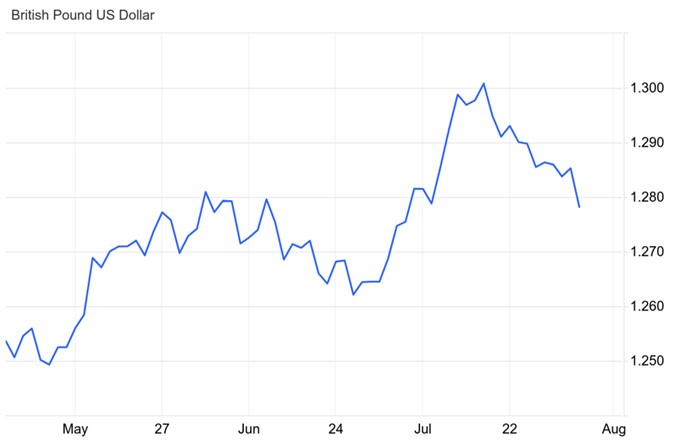GBP-USD Exchange rate touches 51-week high above 1.30
The pound dollar exchange rate touched a six-week low around 1.263 on 2 July amid rising odds of former president Donald Trump returning to office. This followed the US Supreme Court decision granting Trump some immunity for attempting to reverse the last election.
Confirmation of the UK’s general election result caused the pound to break through 1.28 against the dollar on 5 July. Despite the Labour Party’s landslide victory, which ended 14 years of Conservative rule, the UK currency’s upward potential was capped by the result being largely priced into markets.
The pound dollar rate was muted for a period before hawkish comments from Bank of England (BoE) policymaker Jonathan Haskel on 10 July. He remarked: “I would rather hold rates until there is more certainty that underlying inflationary pressures have subsided sustainably.”
The pair jumped to a one-year high the following day above 1.29 following the publication of a cooler-than-forecast batch of US inflation data that weighed on the dollar. The figures came hot on the heels of Federal Reserve Chair Jerome Powell’s assertions that easing inflation would pave the way for interest rate cuts.
The pound traded sideways versus the dollar before spiking to a fresh 51-week high a fraction above 1.30 on 17 July, buoyed by persistent inflationary pressure. This followed a higher-than-expected UK headline inflation reading which printed at 2% rather than the 1.9% forecast. The stubborn reading prompted investors to dial back bets on an August rate cut from the BoE.
By 19 July the UK currency had toppled from its peak, falling by around 1% after being undermined by lacklustre UK retail sales data. The numbers confirmed that sales volumes plummeted by 1.2% in June following May’s 2.9% surge.
The dollar firmed slightly, capturing some safe-haven flows, as investors digested US President Joe Biden’s decision to pull out of his re-election campaign, which is expected to intensify volatility in the currency market. The news consolidated Republican nominee and Former President Donald Trump’s strong lead in betting markets.
Having hit a 13-day low on 24 July, after the dollar was lifted by a risk-off market mood, the pound rebounded following the publication of contrasting PMI data on both sides of the Atlantic. The UK currency was bolstered by increasing business activity in July after a lull ahead of the general election. Meanwhile, the dollar was dented by weaker-than-forecast US manufacturing activity.
The pound slumped to the 1.28 mid-range versus the dollar on 25 July following a better-than-forecast GDP report in the US. The US economy expanded by 2.8% between April and June, beating market forecasts of 2% and jumping higher from the first quarter’s sluggish 1.4% growth.
The dollar held firm on 26 July despite news of easing price pressures and a cooling labour market that stoked September Fed rate cut hopes.
The pound dollar exchange rate dropped towards 1.18 on 30 July ahead of the BoE’s policy decision on 1 August as interest rate cut bets ramped up.
GBPUSD: 3-Month Chart

Looking ahead
Economists were split about whether the BoE would choose to start cutting interest rates on 1 August. The Bank Rate has stood at 5.25% since last August, but policymakers have been weighing up rate cuts recently as inflation has come back under control.
Influential data from the UK economy in August: ILO Unemployment Rate (13 August), Consumer Price Index (14 August), Gross Domestic Product (15 August), Retail Sales (16 August), S&P Global/CIPS Composite PMI (23 August).
The next Fed policy meeting is scheduled for September, which brings inflation figures for July into sharp focus on 14 August. If they show that price pressures are continuing to ease, rate cut expectations will increase.
Influential data from the US economy in August: ISM Manufacturing PMI (1 August), Nonfarm Payrolls (2 August), ISM Services PMI (5 August), Producer Price Index excluding Food and Energy (13 August), Consumer Price Index (14 August), Retail Sales (15 August), Michigan Consumer Sentiment Index (16 August), S&P Global Composite PMI (21 August), Gross Domestic Product (29 August), Core Personal Consumption Expenditures Price Index (29 August).






